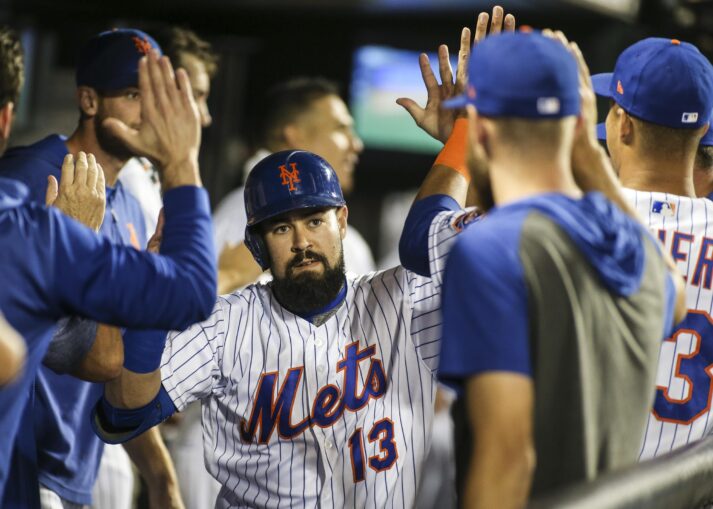
Francisco Lindor is coming to Queens, and with him comes some clarity for the Mets infield. Now that the Mets no longer need to sort out playing time for Amed Rosario and Andrés Giménez, and Robinson Cano is a problem that can wait until next year, the Mets’ infield situation suddenly looks fairly simple.
Pete Alonso and Dominic Smith will split time at first. Smith may also get playing time in left field, particularly if the Mets don’t add another outfielder, but regardless, first base is settled. Jeff McNeil will likely play second base: he’s also played third, left, and right in his career, but second has been his best defensive position. Lindor, obviously, will play short.
Third base, however, remains in question. The Mets have two main options: Luis Guillorme and J.D. Davis. They also have several options via trade: just yesterday, reports tied the Mets to Kris Bryant and Kyle Seager. If the Mets stick with their in-house options, though, who gets the bulk of the playing time at third, or whether Davis and Guillorme split it more or less evenly, is one of the least known aspects of the 2021 season.
Davis and Guillorme offer more-or-less opposite profiles as third basemen. Guillorme has some of the softest hands in baseball; Davis…well, doesn’t. Davis hits the ball harder than just about anyone; Guillorme was fantastic on offense in 2021, but had a .463 BABIP that will likely sink like a stone tossed into Flushing Bay in 2021. Davis, more or less, hits and fields like a first baseman, albeit with a great arm; Guillorme hits and fields like a shortstop.
In their press conference yesterday addressing the Lindor trade, Sandy Alderson and Jared Porter didn’t offer much insight as to who would be the Mets’ main third baseman. They talked up Davis as an excellent hitter and a hard worker, constantly improving his defense. They also went out of their way to mention Guillorme. Translation: you’ll know when you see the lineup card.
As for the question of who should get most playing time at third, though, there’s an unorthodox answer: both of them. Right now, a platoon system makes by far the most sense. Once the season starts, it should be constantly re-evaluated, and if either Guillorme or Davis improves or regresses, their playing time should be updated to reflect that. But for now, the most effective strategy for the Mets is to split their time at third.

Davis is a right-handed hitter, and Guillorme bats lefty. In Davis’ career, he’s been better against lefties, as expected, but not by much. In 2019, his last full season, Davis had a .913 OPS against left-handers. Against righties, it was .886. In 2020, Davis had a similar righty/lefty gap: his OPS against left-handers was .771, compared to .755 against righties. The numbers are close enough that it’s fair to say, at least in the last few years, that it doesn’t really matter whether Davis is facing a lefty or a righty.
Guillorme is a different story. In his career, his OPS against righties is .723; against lefties, it falls to .513. Last season, his righty/lefty gap careened towards absurdism: against righthanders, his OPS was .938, while against lefties (albeit in only eight at-bats), it was .425. That’s obviously too small a sample to judge; even in his career, Guillorme has only made 38 plate appearances against left-handed pitchers. That might be because the Mets know he can’t hit lefties; it might also be because he just hasn’t gotten that much playing time.
At the start of the 2021 season, the Mets will have to answer a few questions. Has Davis’ defense improved? Can Guillorme really hit, or were his outstanding 2020 numbers a high-BABIP fluke? Can Davis rediscover his 2019 stroke, which allowed him to post an .895 OPS? Even if Guillorme can hit, can he hit lefties?
The only way to answer these questions is to find playing time for both of them. If the trends of their careers so far continue — if Guillorme can hit, but not really against lefties; if Davis is excellent on offense, but clunky on defense — then it will make sense to continue splitting their time, Davis against lefties and Guillorme against righties. If Davis has somehow improved his fielding, he can earn himself a starting job. If Guillorme proves that he can hit lefties as well as righties, he can do the same.
In sports, people are always talking about “good problems to have.” This isn’t exactly one of them, but it’s not a terrible problem either. The Mets, for now, have two options at third base; both are fine, but flawed. The best way to use them is to minimize how much their respective flaws are exposed and exploited. The only way to do that is to determine exactly what their flaws are. How do the Mets do that? By splitting their playing time until they figure out exactly what each player has to offer.















